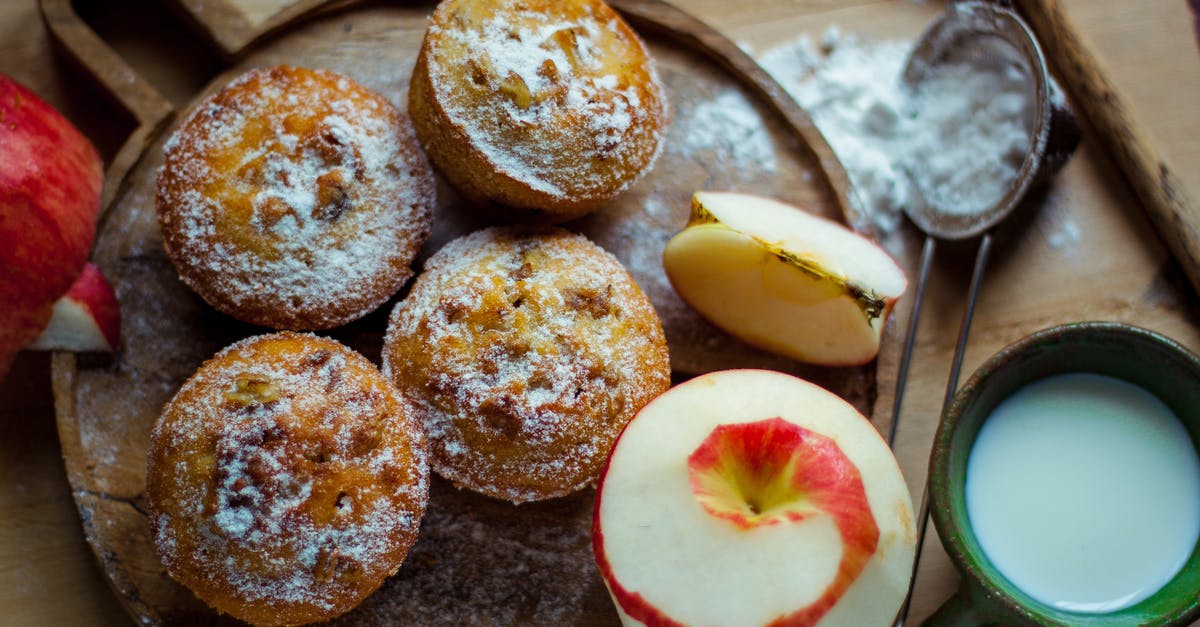Smallest muffin size without losing the muffin top?

This is a question about the physics of muffins. With a standard size muffin tray, when filled with batter, the heat and expansion causes the dough to spill over the edge and form the classic muffin top. But with smaller and smaller tray sizes the amount of expansion will eventually just be a bump that does not spill over the sides. What is the theoretical minimum muffin size, assuming standard muffin batter (no upping the baking powder). would it be possible to make breakfast-cereal sized muffins?
Best Answer
First, you must assume a spherical muffin. This is a silly but fun question, so lets think about the limiting factors.
What if you could scale down everything (the pan, the size of the ingredients, the size of the gas cells, everything else) uniformly.
If that could be done, muffin tops would be a uniform phenomenon at any size.
So, what can we not scale down uniformly?
It seems to me that there are to major factors that cannot be uniformly scaled down in actual practice:
The cell-size of the starch matrix that is expanded by the leavening. It has a minimum size, and one would imagine that muffins must be macro-scaled compared to the cell size in order to work.
Since the cell size is visible as the grain in an actual muffin, the muffin has an internal structure on the order of millimeters, typically (I haven't baked muffins just now to measure their structure size) based on my best guess and recollection. This is taking into account some of the larger scale structures within the muffin, like bubbles, and that "grain" which is composed of even finer "grains".
So one limiting factor would be that the muffin would have to be several orders of magnitude larger than tenths of millimeters, say three orders of magnitude. That would bring the limiting size of muffin-topped muffins to about a centimeter across.
Heat penetration.
We can assume the rate of cooking in the muffin is proportional to the radius of the muffin at any given size, as a first order approximation, for any given temperature.
At some point, the muffin will either cook through before it can expand, or burn on the outside before it cooks through.
The problem with tiny baked goods is that they are outside any effective balance of temperatures. Either they cook through and start drying out without any good crust development, or the outside is overdone before the inside gets cooked.
The requirement for muffins is even more balanced: it has to heat the inside enough to trigger the oven spring from the leavening before the outside is set enough that it cannot expand, while still being able to cook all the way through, set the outside, and get decent crust development.
This is very hard to manage.
Practically, it is likely that the current mini-muffin pan size (a couple of centimeters across) is about as small as you can go without having to start taking drastic measures with the recipe. The main problem is heat management: getting good oven spring without the muffin setting too fast, while cooking it through, and yet having nice crust development on the outside.
You can have smaller baked goods, but they have a much simpler structure. They are called cookies. Most muffin batters would make an effective drop cookie, again probably down to about 2 cm. They would be essentially all muffin top.
For a look at some of these practical factors, see:
See also: How to adapt brownie recipe to cook well in a mini-muffin tin?
Pictures about "Smallest muffin size without losing the muffin top?"



Quick Answer about "Smallest muffin size without losing the muffin top?"
These are slightly smaller than other mini liners I have had in the past, but fit my pans. As long as you leave 1/4-inch unfilled at the top, you won't get muffin tops. When batter is too much and spills over pan, they are harder to remove from pan, but still work.Are there different size muffin tins?
Beyond that, muffin cups are sized as follows: Mini (1 inch), Standard (2 inches), or Jumbo (2.5 inches). Though most muffin batters can be used for all the different sizes of cups, the amount of batter to be used and the baking time must be adjusted so it's good to keep the size in mind.What is a standard size muffin tin?
Typically, standard baking cups measure 2" x 1 1/4" and are commonly used for traditional-sized cupcakes or muffins. Mini baking cups with a 1" diameter can be used for presenting chocolate covered cherries or caramels, and 3 1/2" diameter jumbo baking cups can be used for gorgeous gourmet cupcake creations!Can you bake 6 muffins in a 12 muffin tin?
Suppose you have a 12-cup muffin tin and enough batter for only, say, six muffins. This myth says to fill the empty cups with water or you'll get uneven baking and your tin might warp. It does no harm, but it's a waste of time and has no effect whatever on the evenness of cooking.LOSE MUFFIN TOP FAT in 10 Days (love handles) | 10 minute Home Workout
Sources: Stack Exchange - This article follows the attribution requirements of Stack Exchange and is licensed under CC BY-SA 3.0.
Images: SHVETS production, Tim Douglas, Piotr Arnoldes, TIVASEE
